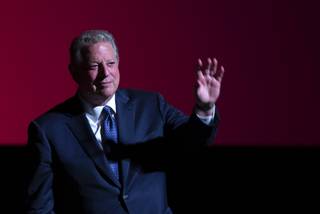
Former Vice President Al Gore speaks during an event titled “The Global Sustainability Revolution: A Conversation with Al Gore” at UNLV’s Ham Hall Tuesday, April 30, 2019.
Tuesday, April 30, 2019 | 6 p.m.
If you think it’s hot in Las Vegas now, Al Gore says, just be glad it’s not the year 2100.
Gore told an audience at UNLV today that if global warming continues at its current rate, the number of days above 95 degrees in the valley will increase more than 50 percent by that year — from 75 now to 132 then.
And despite the claims of deniers who say such changes are merely the result of natural shifts in the weather, Gore said the cause was undeniably the greenhouse gases that are causing the earth to absorb an amount of energy equivalent to 500,000 Hiroshima atomic bombs exploding every day.
“We have to get busy making changes,” he said.
Before a crowd of about 2,000 people at the university’s Ham Concert Hall, the former vice president offered an hour-plus barrage of statistics, images, videos and charts designed to bury any doubt that the planet is getting dangerously hotter due to man-made causes.
Among his points:
• In the last two years, damage from climate-related events has been estimated at $653 billion.
• Since May 2010, there have been 17 downpour events that were once thought to be once-in-1,000-year floods.
• Eighteen of the 19 hottest years ever measured have been since 2001, and the hottest of all have been the last five years.
• 2018 was the hottest year on record in 29 countries, and the May-through-July period last year was the hottest in the U.S. on record.
Gore, the subject of the 2006 Oscar-winning documentary “An Inconvenient Truth” and a 2017 sequel, discussed the health and global security implications of climate change as well as the costs.
Drought and extreme weather events will result in an estimated 1 billion refugees, Gore said, and is already driving such migrations as the influx to the U.S.-Mexico border. Those migrants are coming largely from the Northern Triangle nations of Honduras, El Salvador and Nicaragua, which, Gore noted, had been particularly hard-hit by drought in recent years. The violence and poverty that are driving people out of those countries are directly related to the drought’s effects on agriculture, he said.
“Experts say the main reason they’re moving is they don’t have anything to eat,” Gore said.
On the plus side, Gore offered an array of statistics showing an explosion in the use of renewable energy worldwide. Costs of solar, wind and geothermal power generation are decreasing steadily, he showed, while many nations are either producing all or most of their power from those sources.
“And by the way, the famous coal museum in Kentucky just installed solar panels on its roof,” he said, drawing a laugh as he showed a slide of the museum.
Gore said that despite Donald Trump’s support for the coal industry, more coal-fired plants have closed during the first two years of his administration than during Obama’s years in office. Meanwhile, he said, state after state had committed to using more renewable energy, as have dozens of cities.
Referring to his opening theme — that global warming boiled down to the questions of should we, can we change and will we change — Gore closed his presentation with an affirmational note.
“We have to change. We can change. I believe we will change,” Gore said.
One reason for his optimism: Activism among young people like many of the people in his audience. He noted that 17 Young Republican groups on campuses have sent a joint message to the Republican Party threatening to withdraw from the party unless it changes its platform on renewable energy.
“The new, rising generation is demanding a cleaner future,” he said. “These young people are serious about this, and they ought to be. Young people traditionally have the energy and drive, and on an issue like this they realize they’ll have to live with the consequences for much longer, so they’re taking the lead.”
Gore has visited Las Vegas several times. He spoke at the Clean Energy Summit here in 2009 and 2017. Before making his presentation, Gore met with members of UNLV’s elite Solar Decathlon team, which has finished near the top in an annual U.S. Department of Energy competition for designing sustainable housing.
Seated with UNLV acting president Marta Meana and former Senate Majority Leader Harry Reid onstage after his presentation, he urged all students to get involved in the issue.
“Use your voice,” he said. “But most importantly of all, use your vote. It’s important to change the light bulbs, but it’s much more important to change the laws and policies.”

